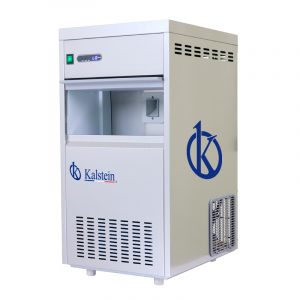An ice maker is a piece of equipment where the water is poured into a tray that has a specific format to shape the ice that you want to create. The tray freezes slowly and gradually in layers until the water freezes completely and creates the ice cubes. Once the correct temperature is reached, the tray heats up enough to allow the cubes to separate. The cubes are deposited in the storage tank.
What aspects should you know about an ice maker?
In an ice maker, the water comes from an outside source and rises through a tremendously icy metallic coating, which, in less than 60 seconds, turns the water into columns of ice. A stainless steel spiral is responsible for raising the ice to the upper part of the machine, where a rotating arm is responsible for splitting the columns, turning them into cubes and sending them to the freezer where they are stored.
Thanks to a sensor located above the freezer and inside the machine, the machine will stop making ice when the freezer where they are stored no longer has enough space to hold more cubes. These cubes can be of different shapes since, depending on the ice machine, they can come out in one way or another, but the most common are square and cylindrical ice cubes, although it can also be dispensed in the form of flakes or “chopped”.
Flake ice, unlike cubes, comes in the form of small, irregularly shaped pieces. Normally this type of ice was obtained by crushing ice into bars, although this method has become obsolete because it is not economically and energy efficient.
How does the ice maker work?
The water comes from an external source and rises through a tremendously icy metallic coating, which, in less than 60 seconds, turns the water into columns of ice. A stainless steel spiral is responsible for raising the ice to the upper part of the machine, where a rotating arm is responsible for splitting the columns, turning them into cubes and sending them to the freezer where they are stored.
Size and capacity
Storing ice can use up a lot of space. It is important to find the perfect balance between the area you have available and the amount of ice you need to store in a given period of time. If you have room to spare, the best option is a modular machine and a large container to store it, always taking into account how much your premises need to avoid wasting or wasting space.
What are the uses of an ice maker?
First, it is possible to make a large amount of ice per day because some ice makers have the capacity to make up to 450 kg of ice cubes in 24 hours. This means that you will never be short of supplies since you can manufacture it in a short time and continuously. In addition, the economic aspect will also benefit since with a minimum investment you will not have to continue using wholesale suppliers who charge their ice bags at a price much higher than the real cost of manufacture.
Manufacturing machines are, today, an essential piece in the best laboratories and hospitals in the world. And is that the ice they produce is a great ally for most professionals in the health sector. As a consequence, the majority of health centers, laboratories, hospitals and research centers include an ice maker in their equipment, either for cubes or granular ice. On the other hand, diagnostic laboratories that perform analytics, take tissue samples, or research centers, need to have granular ice to preserve the samples.
Where to install my ice machine?
It is important that the machine is in a place that is not very hot, but not excessively cold. For this reason, in laboratories it is recommended to place it as far as possible from ovens and other equipment that give off heat. Of course, the place must be easily accessible to easily connect with electricity and water and with enough space for the machine to cool naturally. HERE
At Kalstein we are MANUFACTURERS and we offer you an excellent ice maker at the best PRICES. That is why we invite you to take a look: HERE


